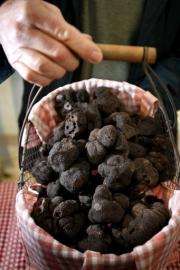Scientists scent breakthrough in truffle trafficking

One of Europe's gastronomic jewels, the fabled black Perigord truffle, has been genetically unravelled, a feat that could doom fakers who pass off inferior truffles as the real thing, scientists said on Sunday.
The truffle, found mainly in France but also in Spain and Italy, is known by its Latin name of Tuber melanosporum.
But to truffle fanatics in the southwestern French region of Perigord, the warty, golfball-sized fungus is known as the "black diamond."
It can reach 1,000 euros a kilo (605 dollars a pound) at local farmers' markets, and several times more at shops in Paris.
A tri-nation group led by geneticists at France's National Institute for Agricultural Research (INRA) says that the truffle has a DNA signature pointing to its geographical origins.
Its genome comprises 125 million base pairs -- the "rungs" on the double-helix genetic ladder -- which encompass 7,500 genes, of which 6,000 are shared by other fungi.
The remaining 1,500 genes play a key role in the truffle's development and its symbiosis, or linked growth, with the roots of a host tree, predominantly the oak.
In addition, the genome is studded with DNA telltales crafted by the nature of the soil and other local factors.
Ten of these markers will go to a "truffle databank," covering some 50 areas in France, Italy and Spain where T. melanosporum is found.
"This database of genetic fingerprints will help identify the regional origin of harvested truffles and set up the means to certify these products and detect any frauds," INRA said.
Truffle hunters in France use trained pigs or dogs to sniff out the delicacy, which is found buried just under the soil surface.
They are incensed by the incursion into the market of cheap rivals, especially Chinese truffles that are often passed off as "black diamonds."
One of these Chinese species is sometimes seeded with extracts from the real T. melanosporum to boost a lacklustre aroma. Another is rarer but is so similar to T. melanosporum that, until now, the only sure way to distinguish the two is analysis by an expert.
Truffle associations are calling for the European Union (EU) to create a special appellation or origin to protect their national treasure.
The genome, which took five years to compile, is reported online by the British journal Nature.
(c) 2010 AFP














